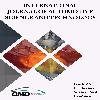Mechanical Evaluation of Road Durability Test in Battery Electric Buses
Electric bus, Road durability test, Critical component detection, Vehicle design, Mainte-nance, Maintenance
Mechanical Evaluation of Road Durability Test in Battery Electric Buses
Electric bus, Road durability test, Critical component detection, Vehicle design, Maintenance,
___
- [1] M. Hayırlıoğlu, “Toplu Ulaşım Sistemlerinin Faydaları,” Demiryolu Mühendisleri Derneği, pp. 42–46, 2015.
- [2] EuroNews, “Almanya’da aylık 9 euroluk toplu taşıma ücreti uygulaması kabul edildi,” 2022. https://tr.euronews.com/2022/05/21/almanya-da-toplu-tas-ma-ucretlerine-indirim-yap-ld
- [3] Goverment of Netherlands, “Types of Public Transport,” 2022. https://www.government.nl/topics/mobility-public-transport-and-road-safety/public-transport/types-of-public-transport
- [4] M. Wu and W. Chen, “Forecast of Electric Vehicle Sales in the World and China Based on PCA-GRNN,” Sustain., vol. 14, no. 4, 2022, doi: 10.3390/su14042206.
- [5] International Energy Agent, “Global electric car sales,” 2022. https://www.iea.org/news/global-electric-car-sales-have-continued-their-strong-growth-in-2022-after-breaking-records-last-year
- [6] Ö. Yavaş, E. Savran, B. E. Nalbur, and F. Karpat, “Energy and Carbon Loss Management in an Electric Bus Factory for Energy Sustainability,” Transdiscipl. J. Eng. Sci., vol. 13, pp. 97–110, 2022, doi: 10.22545/2022/00207.
- [7] Environmental Protection Agency, “Clean School Bus Program,” 2022. https://www.epa.gov/cleanschoolbus
- [8] C. Işilak, “Elektrikli Araçların Konvansiyonel Araçlara Göre Gövde , Şasi ve İç Trim Açısından Tasarım Farklılıkları,” vol. 1, no. 1, pp. 46–58, 2020.
- [9] H. U. Çırak, “Filo Araçları Bakım Çizelgeleme,” Sakarya Üniversitesi, 2009.
- [10] G. Şentürk, “Hi̇bri̇t otobüs seyi̇r hali̇ emi̇syonlarının ölçüm ve modellemesi̇,” Sakarya Üniversitesi, Fen Bilimleri Enstitüsü, 2009.
- [11] A. Ç. Önçağ, H. Üzkat, Z. C. Yeşil, and U. Eliiyi, “Elektrikli otobüsler üzerine karşılaştırmalı bir değerlendirme: İzmir şehir içi saha analizi,” Pamukkale Univ. J. Eng. Sci., vol. 27, no. 1, pp. 43–51, 2020, doi: 10.5505/pajes.2020.99582.
- [12] M. Gül, “Biodiesel ile Çalıştırılan Belediye Otobüsünün Egzoz Emisyonlarının Nümerik Yöntemle Etüdü,” Yıldız Teknik Üniversitesi, 2008.
- [13] D. Chindamo, M. Gadola, and F. P. Marchesin, “Reproduction of real-world road profiles on a four-poster rig for indoor vehicle chassis and suspension durability testing,” Adv. Mech. Eng., vol. 9, no. 8, pp. 1–10, 2017, doi: 10.1177/1687814017726004.
- Yayın Aralığı: 4
- Başlangıç: 2016
- Yayıncı: Otomotiv Mühendisleri Derneği
Mustafa AKIN, Mehmet Can DURMUŞ, İmren MEYDAN, Emel ATILAL
Brazing of Different Metal Alloys with Highly-Silver Flux Addition and Microstructure Investigation
A Gear Form-Grinding Optimization Method Based on Neural Network
Emrah ERÇEK, Şükrü Ayhan BAYDIR
Mechanical Evaluation of Road Durability Test in Battery Electric Buses
Efe SAVRAN, Burcu YILDIRIM, Umut ÇANDIR, Fatih KARPAT
Modeling of Electric Vehicles as a Load Of The Distribution Grid
Nurullah ASLAN, Erdal KILIC, Mustafa ŞEKKELİ
Case Study of Intralogistics in The Framework of Logistics 4.0
Performance Analysis of Geometric Properties of Fuel Cell Components
